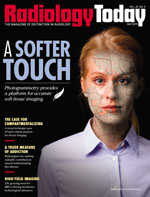 CT Slice: Upward Mobility
CT Slice: Upward Mobility
By Samir Makani, MD
Radiology Today
Vol. 20 No. 5 P. 8
Mobile CT helps guide the future of interventional pulmonology.
When a 66-year-old patient walked through my doors with a nodule in her lung—one not easily accessible by way of a minimally invasive method, ie, CT-guided biopsy or standard navigational bronchoscopy—I told her we’d have to pursue open surgery to biopsy it. However, she was hesitant and didn’t want to undergo an invasive operation without a clear diagnosis of cancer. Looking at her clinical images, I couldn’t give that to her with certainty.
A year and a half ago, I would have hit a wall there. The methods I used then, such as fluoroscopy, peripheral endobronchial ultrasound, and navigational bronchoscopy, weren’t able to offer the image clarity or accuracy I needed to make a diagnosis.
Fortunately, I had another tool in my arsenal: a mobile intraoperative CT scanner. I was able to accurately navigate to the lesion using NeuroLogica’s BodyTom portable 32-slice CT scanner and diagnose adenocarcinoma with the assistance of 3D imaging. I then proceeded with a successful lobectomy. The patient is now cancer-free.
Evolution in the Field
While interventional pulmonologists have been using CT in their practices since the 1980s, we’re just now beginning to utilize mobile CT in the field. Beyond lower-quality slice thickness, the primary issue with using standard CT in practice was competing for time and resources within a facility’s CT suite. Adding intraoperative mobile CT to our arsenal of diagnostic methods, including endobronchial ultrasound and navigational bronchoscopy, has enabled us to bring the CT suite directly into the operating room (OR).
Key features of mobile CT that immediately made a difference were specific aspects of its portability and functionality. With a small footprint, the machine moved in, out, and around the OR with ease. Additionally, having the scanner move over the patient—instead of moving the patient through the machine—produced accurate, high-resolution images that enabled my team to move forward with diagnostics at an accelerated rate.
Still, there were some initial challenges. First, my team and I had to determine whether the device could provide valuable images, considering refraction in relation to the bronchoscope and peripheral biopsy tools such as needles and forceps, all of which are made of metal. To do this, we started by using a lung model on a bed with a flexible bronchoscope and our biopsy tools.
After seeing that we could still produce high-quality images, we had to tackle our next challenge: room setup. My team worked to reposition critical pieces of equipment—and staff—to ensure we had the best possible OR format. This took a few tries, but we ultimately ended up with a layout that has been conducive to safe, successful, and efficient procedures.
Additionally, we worked out the best way to combat lung atelectasis during imaging. While patients are under general anesthesia, their breathing is shallow, and we need a completely expanded lung to produce the best image. Ultimately, we used endotracheal tubes to maintain a closed circuit and avoid leakage of air, providing an enhanced, crisp image. This was particularly important in lesions located in the lower lobes of the lungs.
Lastly, the effects that instilling fluid in the lung have on imaging had to be addressed. Normally, fluid would be instilled at the beginning of the procedure to obtain a specimen, but this led to image degradation and the inability to clearly identify the lesion in question. To combat this, the order in which samples are obtained was altered; fluid instillation was moved to the last step to maintain image quality during either needle biopsy or forceps biopsy.
Expanded Use
Compared with fluoroscopy and cone beam CT, mobile CT offers improved accuracy and image quality with true CT images derived from 1.25-mm slices, the same quality offered in a standard, nonmobile CT unit. I’m also able to obtain better images with lower radiation exposure to our patients. The scanner’s movement throughout Scripps Health showcases its high utilization rate. My colleagues have used it for neurosurgery cases, and future uses include scanning in the ICU and lung cancer screening.
Moreover, being able to diagnose patients with nodules that are small or in hard-to-reach areas of the lung has allowed us to provide earlier therapies for patients whom we previously may not have not been able to diagnose. We have also noted an increase in the number of patients we can care for. This has led to an increase in the total number of patients undergoing bronchoscopy and biopsy. In turn, this has also increased the number of surgical cases for video-assisted thorascopic surgery lobectomies.
Along with these benefits, mobile intraoperative CT is almost one-half the cost of cone beam CT. To date, we’ve utilized mobile CT on 110 procedures, and all of my patients with nodules benefit from the technology, whether it’s an 8-mm nodule or a 3-cm mass. Beyond its utility in my own practice of evaluating those with lung lesions, the unit has proved useful across other departments in my facility as well.
Looking forward, I’m excited about the expanding uses for mobile CT in interventional pulmonology. We’re only at the beginning stages, and, as a field, we are working toward treating lung cancer bronchoscopically in a minimally invasive fashion. Without the 3D imaging provided by mobile CT, this advancement wouldn’t be possible. Now, we’re one step closer.
— Samir Makani, MD, is the director of interventional pulmonology at Scripps Health in Encinitas, California.

